Timpani
 From Nwe
From Nwe 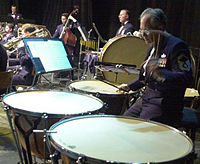
Timpani (also known colloquially as kettledrums) are musical instruments in the percussion family. A type of drum, they consist of a head, formerly made of animal skin but today usually of synthetic material, stretched over a large bowl commonly made of copper. Unlike most drums, they produce a definite pitch when struck. This feature enables them to play a significant role in symphonic pieces such as Gustav Mahler's Symphony No. 2, Ludwig van Beethoven's Symphony No. 9, and the "Triumphal Procession" from Sergei Prokofiev's "Peter and the Wolf."
Timpani evolved from military drums to become a staple of the classical orchestra by the last third of the eighteenth century. Today, they are used in many types of musical ensembles including concert, marching, and even rock bands. They are played by striking the head with a specialized drum stick called a timpani stick or timpani mallet. Modern timpani often feature pedal mechanisms which allow their pitch to be altered during performance.
Timpani is an Italian plural, the singular of which is timpano. However, this is rarely used in informal English speech. A musician who plays the timpani is known as a timpanist. While the word timpani has been widely adopted in the English language, some English speakers refer to them as kettledrums. The German word for timpani is pauken, and the French is timbales. In the Sachs-Hornbostel classification, it is thus considered a membranophone.
Construction
Basic timpani

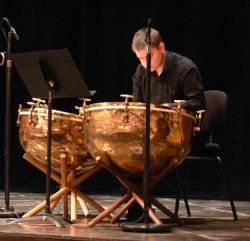
The basic timpano consists of a drumhead stretched across the opening of a bowl typically made of copper or, in less expensive models, fiberglass and sometimes aluminum. The drumhead is affixed to a hoop (also called a fleshhoop), which in turn is held onto the bowl by a counterhoop, which is then held by means of a number of tuning screws called tension rods placed regularly around the circumference. The head's tension can be adjusted by loosening or tightening the rods. Most timpani have six to eight tension rods.
The shape of the bowl contributes to the tone quality of the drum. For example, hemispheric bowls produce brighter tones while parabolic bowls produce darker tones. Timpani come in a variety of sizes from about 84 centimeters (33 inches) in diameter down to piccolo timpani of 30 centimeters (12 inches) or less. A 33-inch drum can produce the C below the bass clef, and specialty piccolo timpani can play up into the treble clef.
Each individual drum typically has a range of a perfect fifth to an octave. Changing the pitch of a timpano by turning each tension rod individually is a laborious process. In the late nineteenth century, mechanical systems to change the tension of the entire head at once were developed. Any timpano equipped with such a system may be called machine timpani, although this term commonly refers to drums that use a single handle connected to a spider-type tuning mechanism.
Pedal timpani

By far the most common type of timpani used today are pedal timpani, which allow the tension of the head to be adjusted using a pedal mechanism. Typically, the pedal is connected to the tension screws via a spider-like system of metal rods.
There are three types of pedal mechanisms in common use today:
- The ratchet-clutch system uses a ratchet and pawl to hold the pedal in place. The timpanist must first disengage the clutch before using the pedal to tune the drum. When the desired pitch is achieved, the timpanist must then reengage the clutch.
- In the balanced action system, a spring or hydraulic cylinder is used to balance the tension on the timpani head so that the pedal will stay in position and the head will stay at pitch. The pedal on a balanced action drum is sometimes called a floating pedal since there is no clutch holding it in place.
- The friction clutch or post and clutch system uses a clutch that moves along a post. Disengaging the clutch frees it from the post, allowing the pedal to move without restraint.
Any pedal drums that are tuned using the spider system can be called Dresden timpani, though the term is most often used for drums whose design is similar to the original pedal timpani built in Dresden. Strictly speaking, a Dresden drum has a pedal that is attached at the player's side. The timpanist can move this pedal with ankle motion. A Berlin-style pedal is attached by means of a long arm to the opposite side of the drum, and the timpanist must use his entire leg to adjust the pitch.
The drums most professional timpanists use are Dresden timpani, commonly with a ratchet-clutch or friction clutch pedal. Most school bands and orchestras below the university level use cheaper, more durable timpani. The mechanical parts of these timpani are almost completely contained within the frame and bowl of the drum. They may use any of the pedal mechanisms, though the balanced action system is by far the most common, followed by the friction clutch system. Many professionals also use these drums for jobs and outdoor performances because of their durability.

Chain timpani
On chain timpani, the tension rods are connected by a roller chain much like the one found on a bicycle, though some manufacturers have used other materials, including steel cable. In these systems, all the tension screws can then be tightened or loosened by one handle. Though far less common than pedal timpani, chain drums still have practical uses. For example, professional players may also use exceptionally large or small chain and cable drums for special low or high notes.
Other tuning mechanisms
A rare tuning mechanism allows the pitch of the head to be changed by rotating the drum itself. In the early twentieth century, Hans Schnellar, then timpanist of the Vienna Philharmonic, developed a tuning mechanism in which the bowl is moved via a handle that connects to the base, and the head remains stationary. These drums are referred to as Viennese timpani (Wiener Pauken) or Schnellar timpani. Adams Musical Instruments developed a pedal-operated version of this tuning mechanism in the early twenty-first century.
Timpani heads
Like most drumheads, timpani heads can be found made from two materials: animal skin (typically calfskin or goatskin) and plastic (typically PET film). Plastic heads are durable, weather resistant, and relatively inexpensive. Thus, they are more commonly used than natural skin heads. However, many professional players prefer skin heads because they feel the heads produce a warmer, better quality timbre. Timpani heads are sized based on the size of the head, not the size of the timpani bowl. For example, a 23" Timpani may require a 25" timpani head.
Sticks and mallets
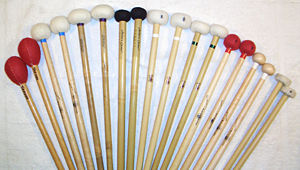
Timpani are typically struck with a special type of drumstick fittingly called a timpani stick or timpani mallet. Timpani sticks are used in pairs. They have two components: a shaft and a head. The shaft is typically made from wood—usually hickory, cherry, birch, persimmon, or maple or bamboo—but may also be made from aluminum or graphite. The head of the stick can be constructed from a number of different materials, though felt wrapped around a wood core is the most common. Other core materials include felt and cork, and other wrap materials include leather. Sticks can also have exposed wood heads. These are used as a special effect and in authentic performances of Baroque music.
Timpanists will change sticks, often many times within the same piece, to suit the nature of the music. However, choice of sticks during a performance is subjective and depends on the timpanist's own preference, or occasionally the wishes of the conductor. Thus, most timpanists own a great number of timpani sticks. The weight of the stick, size of the head, materials used, and the method used to wrap the head all contribute to the timbre the stick produces.
In the early twentieth century and previously, sticks were often made with whalebone shafts, wood cores, and sponge wraps. Composers of that era often specified sponge-headed sticks. Modern timpanists execute such passages with standard felt mallets.
Timpani in the modern ensemble

A standard set of timpani consists of four drums: roughly 80 cm (32 in), 75 cm (29 in), 66 cm (26 in), and 61 cm (23 in) in diameter. The range of this set is roughly the D below the bass clef to the top-line bass clef A. The great majority of the orchestral repertoire can be played using these four drums. Adding a 51 cm (20 in) piccolo timpano to the standard set of four extends the range upwards by a few semitones. This is the instrument which Igor Stravinsky specifies for the production of the B below middle C in The Rite of Spring, and from which Maurice Ravel expects the D above that in L'Enfant et les Sortilèges. Leonard Bernstein requires the timpanist to execute both a top-line bass clef A flat and the B flat above it on the same drum in the Overture to Candide.
Beyond this extended set of five, any added drums are nonstandard. Many professional orchestras and timpanists own multiple sets of timpani consisting of both pedal and chain drums allowing them to execute music that cannot be performed correctly using a standard set of four or five drums. However, many schools and ensembles that cannot afford to purchase equipment regularly only have a set of three timpani, consisting of 75 cm (29 in), 66 cm (26 in), and 61 cm (23 in) drums. Its range extends down only to the F below the bass clef.
The drums are set up in an arc around the performer. Traditionally, North American and French timpanists set their drums up with the lowest drum on the left and the highest on the right, while German and Austrian players set them up the opposite way. Over time, that distinction has blurred: many German and European players have adopted the North American layout and vice versa.
History
Pre-orchestral use

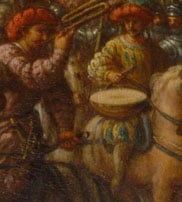
In 1188, Cambro-Norman chronicler Gerald of Wales wrote, "Ireland uses and delights in two instruments only, the harp namely, and the tympanum."[1] Arabic nakers, the direct ancestors of most timpani, were brought to thirteenth century Continental Europe by Crusaders and Saracens. These drums, which were small (with a diameter of about 20–22 cm or 8–8½ in) and mounted to the player's belt, were used primarily for military ceremonies. This form of timpani remained in use until the sixteenth century.
In 1457, a Hungarian legation sent by Ladislaus Posthumus of Bohemia and King Ladislaus V carried larger timpani mounted on horseback to the court of King Charles VII in France. This variety of timpani had been used in the Middle East since the twelfth century. These drums evolved together with trumpets to be the primary instruments of the cavalry. This practice continues to this day in sections of the British Army, and timpani continued to be paired with trumpets when they entered the classical orchestra.
Over the next two centuries, a number of technical improvements were made to timpani. Originally, the head was nailed directly to the shell of the drum. In the fifteenth century, heads began to be attached and tensioned by a counterhoop that was tied directly to the shell. In the early sixteenth century, the bindings were replaced by screws. This allowed timpani to become tunable instruments of definite pitch.
Orchestral use

Jean-Baptiste Lully is the first known composer to have scored for timpani, which he included in the orchestra for his 1675 opera Thésée. Other seventeenth-century composers soon followed suit. Later in the Baroque era, Johann Sebastian Bach wrote a secular cantata titled "Tönet, ihr Pauken! Erschallet, Trompeten!," which translates roughly to "Sound off, ye timpani! Sound, trumpets!" The piece starts with a timpani solo, and the chorus and timpani trade the melody back and forth. Bach reworked this movement in part 1 of his Christmas Oratorio.

Ludwig van Beethoven revolutionized timpani music in the early nineteenth century. He not only wrote for drums tuned to intervals other than a fourth or fifth, but he gave a prominence to the instrument as an independent voice beyond programmatic use such as in Bach's Tönet, ihr Pauken!. For example, his Violin Concerto (1806) opens with four solo timpani strokes, and the scherzo of his Ninth Symphony (1824) sets the timpani against the orchestra in a sort of call and response.
The next major innovator was Hector Berlioz. He was the first composer to indicate the exact sticks that should be used – felt-covered, wooden, etc. In several of his works, including Symphonie fantastique (1830), he demanded the use of several timpanists at once.
Until the late nineteenth century, timpani were hand-tuned; that is, there was a sequence of screws with T-shaped handles, called taps, which altered the tension in the head when turned by players. Thus, tuning was a relatively slow operation, and composers had to allow a reasonable amount of time for players to change notes if they wanted to be sure of a true note. The first pedal timpani originated in Dresden in the 1870s and are called Dresden timpani for this reason. However, since vellum was used for the heads of the drums, automated solutions were difficult to implement since the tension would vary unpredictably across the drum. This could be compensated for by hand-tuning, but not easily by a pedal drum. Mechanisms continued to improve in the early twentieth century.
Despite these problems, composers eagerly exploited the opportunities the new mechanism had to offer. By 1915, Danish composer Carl Nielsen was demanding glissandos on timpani in his Fourth Symphony – impossible on the old hand-tuned drums. However, it took Béla Bartók to more fully realize the flexibility the new mechanism had to offer. Many of his timpani parts require such a range of notes that it would be unthinkable to attempt them without pedal drums.

Most pieces of music of the period from 1700 to 1900 call for one timpanist playing one set of timpani. However, occasionally composers seeking a thicker texture or a greater palette of pitches ask for multiple players to perform on one or many sets of timpani. Gustav Mahler wrote for two timpanists in six of his symphonies. Gustav Holst used two timpanists to achieve the range of notes needed to echo the main theme in "Jupiter" from The Planets suite. Using two timpanists is relatively common in late Romantic and twentieth century works for large orchestras.
Several concertos have been written for timpani. The eighteenth century composer Johann Fischer wrote a symphony for eight timpani and orchestra, which requires the solo timpanist to play eight drums simultaneously. In 1983, William Kraft, a well regarded American percussionist and composer, composed his Concerto for Timpani and Orchestra, which won second prize in the Kennedy Center Friedheim Awards. Gordon Jacob wrote a concerto for timpani and wind band in 1984. In the year 2000, American composer Philip Glass wrote his Concerto Fantasy for two timpanists and orchestra, which has its two soloists each playing seven timpani.
Timpani outside the orchestra
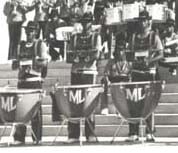
In the 1970s, marching bands and drum and bugle corps, which evolved both from traditional marching bands and concert bands, began to include marching timpani. Each player carried a single drum, which was tuned by a hand crank. Marching timpani were heavy and awkward to play, as the drumhead was almost at the player's chest. Often, during intricate passages, the timpani players would put their drums on the ground by means of extendable legs, and they would be played more like conventional timpani, but with a single player per drum. In the early 1980s, Drum Corps International (DCI), a drum corps governing body, allowed timpani and other percussion instruments to be permanently grounded. This was the beginning of the end for marching timpani: Eventually, standard concert timpani found their way onto the football field as part of the front ensemble, and marching timpani fell out of common usage.
Jazz musicians also experimented with timpani. Sun Ra used it occasionally in his Arkestra (played, for example, by percussionist Jim Herndon on the songs "Reflection in Blue" and "El Viktor," both recorded in 1957). In 1964, Elvin Jones incorporated timpani into his drum kit on John Coltrane's four-part composition A Love Supreme.
When rock and roll bands started seeking to diversify their sound, timpani found their way into the studio. Starting in the 1960s, drummers for high profile rock acts like The Beatles, Led Zeppelin, The Beach Boys, and Queen incorporated timpani into their music. This led to the use of timpani in progressive rock. For example, Emerson, Lake & Palmer recorded a number of rock covers of classical pieces that utilize timpani.
Tuning
Prior to playing the instruments, the timpanist must clear the heads by equalizing the tension at each tuning screw. This is done so every spot on the head is tuned to exactly the same pitch. When the head is clear, the timpano will produce a beautiful, in-tune sound. If the head is not clear, the pitch of the drum will rise or fall after the initial impact, and the drum will produce different pitches at different dynamic levels.

In performance, tuning is typically accomplished with a method called interval tuning. Timpanists who are not blessed with absolute pitch obtain a reference pitch from a tuning fork, pitch pipe, or a note played by another instrument in the course of the performance, then use musical intervals to arrive at the desired note. For example, to tune the timpani to G and C, a timpanist may sound an A with a tuning fork, then sing (or think) a minor third above that A to tune the C, and then sing a perfect fourth below the C to tune the G. Timpanists are required to have a well-developed sense of relative pitch, and must develop techniques to tune undetectably and accurately in the middle of a performance.
Some timpani are equipped with tuning gauges, which provide a visual indication of the drum's pitch. They are physically connected either to the counterhoop, in which case the gauge indicates how far the counterhoop is pushed down, or the pedal, in which case the gauge indicates the position of the pedal. These gauges are accurate when used correctly. However, when the drum is moved, the overall pitch of the head can change, thus the markers on the gauges are not reliable unless they have been adjusted immediately preceding the performance. Gauges are especially useful when performing music that involves fast tuning changes that do not allow the player to listen to the new pitch before playing it. Even when gauges are available, good timpanists will check their intonation by ear before playing.
Occasionally, players use the pedals to retune a drum while playing it. Portamento effects can be achieved by changing the pitch of the drum while it can still be heard. This is commonly called a glissando, though this use of the term is not strictly correct. The most effective glissandos are those from low notes to high notes and those performed during rolls. One of the first composers to call for a timpani glissando was Carl Nielsen in his Symphony No. 4.
Pedaling
Pedaling refers to changing the pitch of the drum with the pedal; it is an alternate term for tuning. In general, timpanists reserve this term for passages where the performer must change the pitch of a drum in the midst of playing – for example, playing two consecutive notes of different pitches on the same drum. Early twentieth century composers such as Nielsen, Béla Bartók, Samuel Barber, and Richard Strauss took advantage of the freedom pedal timpani afforded, often giving the timpani the bass line.

Footnote
- ↑ Topographia Hibernica, III.XI; tr. O'Meary, p. 94.
References
ISBN links support NWE through referral fees
- Adler, Samuel. The Study of Orchestration. W. W. Norton & Company, 3rd edition, 2002. ISBN 039397572X
- Del Mar, Norman. Anatomy of the Orchestra. University of California Press, 1984. ISBN 0520050622
- Kennan, Kent. The Technique of Orchestration. Prentice-Hall, Inc., New Jersey, 1970. ISBN 978-0139003165
- Montagu, Jeremy. Timpany & Percussion. Yale University Press, 2002. ISBN 0300093373
- Peters, Mitchell. Fundamental Method for Timpani. Alfred Publishing Co., 1993. ISBN 073902051X
External links
All links retrieved March 12, 2020.
- Timpani Head Size Guide
- Homepage of John Tafoya, Principal Timpanist, National Symphony Orchestra
- Homepage of Nick Woud, Solo Timpani, Royal Concertgebouw Orchestra
- Homepage of Jonathan Haas, Solo Timpanist, and Principal Timpanist, EOS Orchestra and Aspen Chamber Orchestra
Credits
New World Encyclopedia writers and editors rewrote and completed the Wikipedia article in accordance with New World Encyclopedia standards. This article abides by terms of the Creative Commons CC-by-sa 3.0 License (CC-by-sa), which may be used and disseminated with proper attribution. Credit is due under the terms of this license that can reference both the New World Encyclopedia contributors and the selfless volunteer contributors of the Wikimedia Foundation. To cite this article click here for a list of acceptable citing formats.The history of earlier contributions by wikipedians is accessible to researchers here:
- Timpani history
The history of this article since it was imported to New World Encyclopedia:
- History of "Timpani"
Note: Some restrictions may apply to use of individual images which are separately licensed.
↧ Download as ZWI file | Last modified: 02/04/2023 05:56:46 | 23 views
☰ Source: https://www.newworldencyclopedia.org/entry/Timpani | License: CC BY-SA 3.0
 ZWI signed:
ZWI signed: KSF
KSF